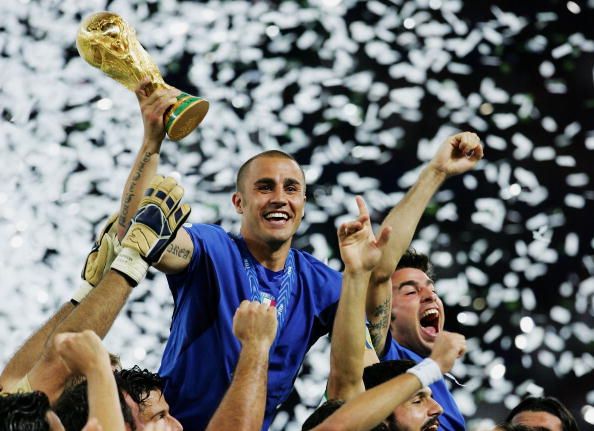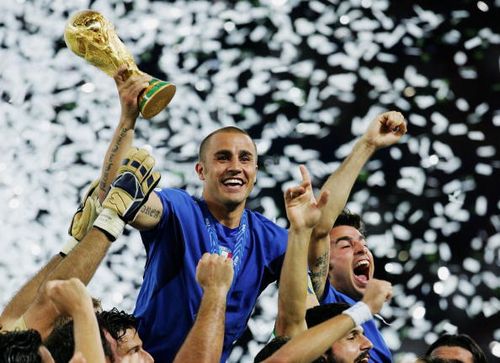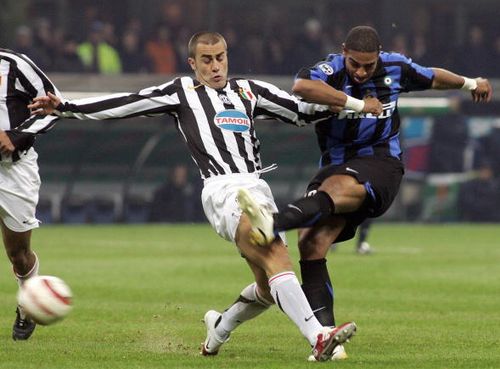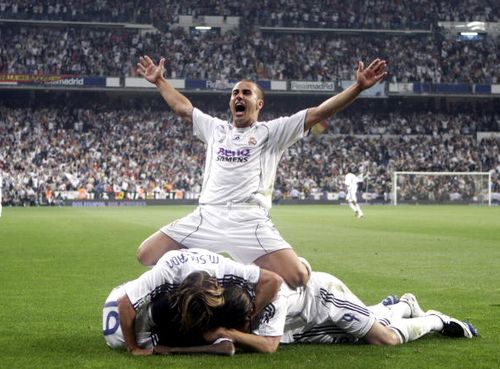
The 10 Most Influential Captains of the Modern Era: Fabio Cannavaro

BERLIN – JULY 09: The Italian players celebrate as Fabio Cannavaro of Italy lifts the World Cup trophy aloft following victory in a penalty shootout at the end of the FIFA World Cup Germany 2006 Final match between Italy and France at the Olympic Stadium on July 9, 2006 in Berlin, Germany.
From a starry eyed ball boy to a World Cup winning captain, from the streets of Naples to lifting the World Cup trophy in Berlin, from a reckless tackler to a Ballon d’Or – Fabio Cannavaro has seen it all. In a career which spanned the best part of two decades – the scugnizzi who learnt his first footballing tricks on the mean streets of Naples and ended as one of the most iconic defenders the world has seen – Cannavaro has sure come a long way.
He was born on 13 September, 1973 in Naples to a father who played football on a part time basis. In a city associated with a rich footballing heritage. He grew up a Napoli fan and joined the club when he was spotted by their scouting network. It was exactly at that time that a certain Diego Armando Maradona was mesmerising the people of the city with his brand of football and Napoli were tasting success with two leagues, a UEFA Cup and two Italian Cups. Cannavaro happened to be on the pitch as a ball boy when Napoli won the Scudetto in 1986-87.
For someone who grew up worshipping one of the legendary forwards of the game, becoming a defender certainly seems an odd choice.
He originally started off as a right midfielder who was converted to a defender when in the U-17’s. At 5ft 9in, he really never had the height we associate with modern defenders – but surprisingly he was one who was rarely beaten in the air by lanky forwards.
“Talking about Fabio’s height is the same as talking about the fog in Milan. I have never felt that he is short when I play with him, because he can jump higher than anybody else. He is always good at heading. It doesn’t make any sense talking about Cannavaro like that.”
- Alessandro Nesta

Football, European Championship, (EURO 2000) Final, Feyenoord Stadium, Rotterdam, Holland, 29th, June,2000France 2 v Italy 1, (on golden goal rule), David Trezeguet of France is under pressure from Italy’s Fabio Cannavaro and Alessandro Nesta
His first moment in the spotlight was during a training session – when the 18-year old Cannavaro put in a crunching tackle on Diego Maradona. His recklessness angered the coaching staff but pleased Maradona who later presented his boots to Cannavaro. He progressed through the ranks quickly and made it to the first team alongside his idols. He was handed his debut in a match against the mighty Juventus in March, 1993 at Stadio delle Alpi – the place which later witnessed the phenomenon of Cannavaro in a Bianconeri shirt.
After the Maradona era, cash-strapped Napoli was forced to sell Cannavaro to Parma. It was at this club that Cannavaro announced his presence as a legend in the making. Alongside Gianluigi Buffon and Lilian Thuram, he formed one of the meanest defences in Europe as they helped Parma to the UEFA Cup in 1998-99 and the Coppa Italia in 1998-99 and 2001-02. His performances did not go unnoticed as he began to feature in the Italian National Team on a regular basis.
His first major international tournament was the 1998 World Cup where Italy was eliminated in the Quarter Finals versus France in a penalty shootout. Cannavaro had a strong impact on the Azzuri performance at Euro 2000. Italy reached the finals conceding only 2 goals in the process, largely due to the backline of Cannavaro, Nesta and Paolo Maldini. However it was the Les Bleus who caused heartbreak once again as they won by a David Trezeguet golden goal.
Cannavaro always had leadership qualities in abundance and it came to the fore during the World Cup in 2002 when Alessandro Nesta was injured in Italy’s second match of the tournament versus Croatia. Thus the centre back partnership was disturbed and Cannavaro had to shoulder the bulk of the responsibility alongside the nervous Marco Materazzi.

ROME, ITALY: AS Roma forward Antonio Cassano (C) challenges Inter Milan’s Fabio Cannavaro (L) and Daniele Adani in a Serie A match at Rome Olympic stadium 07 March 2004.
His €23 million transfer to Inter Milan and the two years spent there was not very productive. He signed for Juventus in 2004 on the transfer deadline day. At the Turin giants, he recreated the fearsome defensive partnership with his ex-Parma teammates Thuram and Buffon and he won the Scudetti in 2005 and 2006. On each of the two occasions, he won the Migliore difensore (Serie A Defender of the Year) after being runner-up for the last three years.
“Cannavaro has this low centre of gravity, which means he is very fast. He reads the game well and always arrives before the forward when he tackles.”
- Former Brazilian international and AC Milan forward Leonardo
Cannavaro’s first big tournament as captain of the national team was Euro 2004. He had taken over the reins of the Italian National Team when Maldini stepped down after the 2002 World Cup. Courageous as he was, he braved a tibia stress fracture to participate. The Azzuri did not leave Portugal with happy memories as a below-par side suffered a group stage exit on goal difference. Cannavaro had to sit out of the last match of the group stage with two cautions picked up in the first two matches with Denmark and Sweden.
It was the year 2006 which saw Cannavaro leave his indelible impression on World football. In the summer of 2006, Serie A was gripped by the expose of Moggigate (better known as the Calciopoli scandal). In the eye of the scandal was Luciano Moggi, the general manager of Juventus.
Club football in Italy was on the brink of a major meltdown when Cannavaro – a Juventus player himself, was tasked with the responsibility of leading his national side. Charges were flying left, right and centre. Italian coach Marcelo Lippi was forced to issue a public denial that his team selection was not influenced by business interests. Buffon was accused of participating in a betting network as a result of which his place in the national side was under threat. Cannavaro was implicated under charges of skulduggery – that he deliberately underperformed at Inter so as to engineer a move to the Bianconeri.

Milan, ITALY: Inter Milan forward Adriano (R) vies with Juventusr Fabio Cannavaro during their Serie A football match Inter Milan-Juventus at San Siro stadium in Milan, 12 February 2006.
His house was raided and he was questioned by magistrates in the lead up to Italy’s World Cup campaign. More importantly, the scandal had the potential to derail their campaign even before it kicked off. The names of the players were being sullied at every opportunity. The senior players were suffering an image crisis. It is at this time that the team was in desperate need of a leader – not a captain, but a leader who would lead the team through the troubled times. Cannavaro was just the man for the job. He played every minute of the tournament, led the team admirably and held the defence together as usual. Italy conceded only one goal from open play all tournament (an own goal), despite an injury to Alessandro Nesta. Cannavaro’s extraordinary performance was in the semi finals versus Germany, about which BBC’s match report states:
“Fabio Cannavaro, exceptional throughout the match, marshalled the Italian back line effectively and limited Germany in the opening period.”
Lifting the World Cup on the night of the 9th of July, 2006 must have been the crowning moment of his glittering career. In a match which was more noted for Zidane’s head butt, Cannavaro was in imperious form and dished out a performance which gave him the title of Muro di Berlino (The Berlin Wall).
He finished runner-up in the race for the Golden Ball and was declared a member of the Team of the Tournament in the World Cup. More accolades would follow. He would go on to become the first defender to win the FIFA World Player of the Year and the third defender (the first two being Franz Beckenbauer in 1972 and Mathias Sammer in 1996) to win the Ballon d’Or award. He would also win the Italian Footballer of the Year.
“Cannavaro is having a fantastic World Cup. He is without question the strongest defender at this tournament and the absolute number one in the world.”
- Marcello Lippi

MADRID, SPAIN – JUNE 17: Cannavaro celebrates a goal during the La Liga match between Real Madrid and Mallorca at the Santiago Bernabeu stadium on June 17, 2007 in Madrid, Spain
After Juventus were relegated to Serie B in the aftermath of the Calciopoli, Cannavaro left for Real Madrid in the fire sale that ensued.
“Fabio being the first player presented has a special symbolic meaning, being that he is the true number one with great leadership skills. We are convinced he will be a role model to help build a winning team. Upon arriving in Madrid, Cannavaro’s first words demonstrated his pride, happiness, and satisfaction for joining such an admired Club.”
-Fiorentino Perez, then Real Madrid President
In his three years at Madrid, he would win the La Liga twice in 2006-07 and 2007-08. He returned to Juventus in 2009 and played for a season.
Cannavaro missed Euro 2008 because of a knock sustained in a training session and the reins of captaincy would be taken up by Alessandro Del Piero. He would bring the curtains down on his international career after captaining Italy to a ignominious group stage exit in the 2010 World Cup.
He moved to Al-Ahli of Dubai in 2010 and played there for a year before a chronic knee injury forced him to quit. In the press conference in which he announced his retirement, he was quoted saying:
“I’m very sad. Football is everything for me in my life”. “It’s not a simple thing. Everyone says it (retirement) has to come. But when it comes, it’s a decision you have to face.”
We leave you with a short video of this leader, this legend.
Catch the rest of this series here: The 10 most influential captains of the modern era